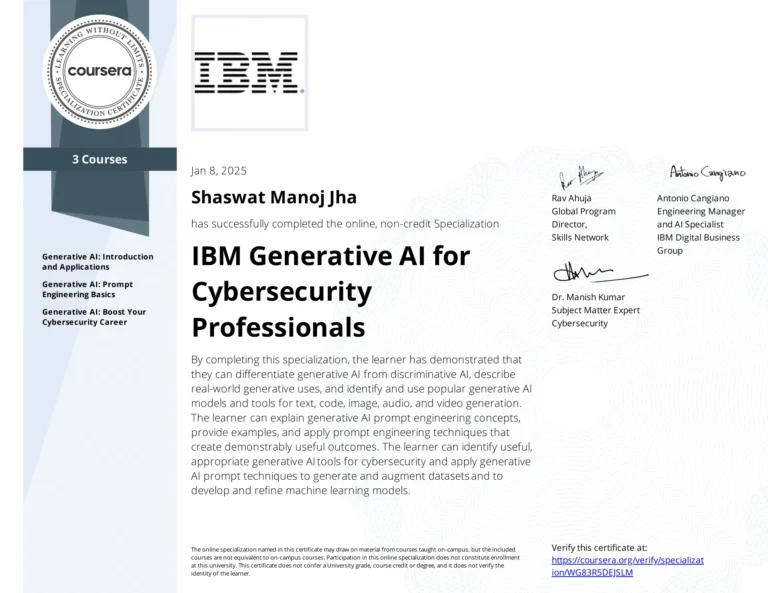IBM Generative AI for Cybersecurity Professionals – Specialization
The IBM Generative AI for Cybersecurity Professionals specialization is an advanced, three-course program that explores how Generative AI (GenAI) can enhance and automate cybersecurity operations.
Developed by IBM Skills Network and delivered on Coursera, this specialization helps professionals understand how AI models can identify, prevent, and respond to cyber threats, while also addressing responsible AI practices such as bias management and explainability.
Through guided projects and hands-on labs, I learned to use large language models (LLMs), apply prompt engineering, and implement AI workflows for tasks such as log analysis, vulnerability reporting, and security documentation automation.
Category
Information Security / Cybersecurity / Artificial Intelligence
Issued By
IBM Skills Network
Platform
Coursera
Completion Date
09th January 2025
Verification Link

Key Learning Modules
Introduction to Generative AI Models – LLMs, diffusion models, and transformers.
Prompt Engineering for Security – Developing optimized prompts for automated analysis and documentation.
AI-Driven Cyber Automation – Threat detection, vulnerability summarization, and automated response generation.
Responsible AI and Governance – Bias detection, ethical AI use, and regulatory alignment for GenAI tools.
Hands-On Labs & Projects – Implementing AI workflows with Python and WatsonX to simulate security operations.
Courses Included in the Specialization
1. Generative AI: Introduction and Applications
This course provides the conceptual foundation for understanding how Generative AI differs from traditional AI.
It covers topics such as neural networks, diffusion models, and transformer architectures. I learned how generative models create text, images, and audio, and how these capabilities can be leveraged in security analytics and communication automation.
Key Takeaway: Understanding GenAI architecture and its use cases in cybersecurity content generation, phishing detection, and log summarization.
2. Generative AI: Prompt Engineering Basics
A practical course focused on developing effective prompts to interact with and control AI systems.
It covered chain-of-thought prompting, temperature tuning, token control, and context optimization.
Through lab exercises, I experimented with crafting prompts for security incident reporting and risk assessment tasks using IBM’s WatsonX AI Studio.
Key Takeaway: Crafting efficient and secure prompts that produce reliable and bias-free cybersecurity outputs.
3. Generative AI: Boost Your Cybersecurity Career
This capstone course integrates GenAI concepts with practical cybersecurity use-cases — such as threat hunting, incident response automation, and security awareness content generation.
I worked on real-world scenarios where AI was used to analyze alerts, generate executive summaries, and recommend mitigation strategies for simulated attack incidents.
Key Takeaway: Applying GenAI technologies to real-time SOC operations, report automation, and GRC documentation.
Course Completion Certificates

Generative AI - Introduction and Applications
Course 1 of 3

Generative AI - Prompt Engineering Basics
Course 2 of 3

Generative AI - Boost Your Cybersecurity Career
Course 3 of 3
Key Learning Outcomes
Developed expertise in AI-driven automation for cybersecurity.
Learned practical prompt engineering methods to improve model accuracy and contextual relevance.
Understood responsible AI governance, bias control, and compliance in security contexts.
Strengthened ability to evaluate, audit, and integrate AI-enabled cybersecurity tools into enterprise environments.
Conclusion
This IBM specialization served as a bridge between AI innovation and cyber resilience, equipping me to leverage Generative AI for enhanced risk analysis, automation, and security governance.
It strengthened my ability to translate complex AI concepts into auditable, compliant cybersecurity processes, a capability that is increasingly vital for future-ready organizations.
